The Satellites of Mercury, 1888-1892
By Kathryn Anne Bratcher
Technical Services Librarian
About |
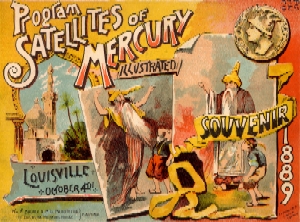 After it closed in 1887 the Board of Trade
called a meeting to plan for something to take its place. It
would still need to promote Louisville’s commercial trade but,
perhaps, a bit differently. At the suggestion of one of its
members, Mr. Peyton N. Clarke, they decided upon a series of
moving tableaus similar to the Mardi Gras celebration of New
Orleans. Since this event was to promote Louisville’s growing
material prosperity, who better to rule over the festival than
Mercury, the Roman mythological god of commerce. Thus the
Satellites of Mercury formed.
After it closed in 1887 the Board of Trade
called a meeting to plan for something to take its place. It
would still need to promote Louisville’s commercial trade but,
perhaps, a bit differently. At the suggestion of one of its
members, Mr. Peyton N. Clarke, they decided upon a series of
moving tableaus similar to the Mardi Gras celebration of New
Orleans. Since this event was to promote Louisville’s growing
material prosperity, who better to rule over the festival than
Mercury, the Roman mythological god of commerce. Thus the
Satellites of Mercury formed.
The Satellites of Mercury held their festival each fall for five years beginning in 1888 as the final event of the month-long Industrial Jubilee Celebration or Fall Commercial Celebration. The Satellites were Louisville businessmen whose identities were kept secret except for Peyton Clarke, who was Chief Satellite and general manager of the organization. During the festivals Satellite members wore masks to protect their identities. They also kept secret the pageant themes and parade routes to build anticipation.
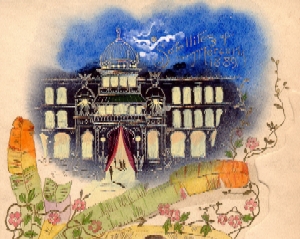 In September of 1888, after six months of
preparation, the Satellites were ready for their first grand
carnivale, which lasted for several days. It began with the
arrival of the King and his dukes by steamboat, followed the
next day by an evening allegorical parade, and finally ended
with a grand ball attended by thousands.
In September of 1888, after six months of
preparation, the Satellites were ready for their first grand
carnivale, which lasted for several days. It began with the
arrival of the King and his dukes by steamboat, followed the
next day by an evening allegorical parade, and finally ended
with a grand ball attended by thousands.
The theme of the first pageant was The Feast of Mercury. The Filson’s special collections department has a wonderful triangular invitation that unfolds into a cone-shaped hat with wings attached, representing Mercury’s helmet. The Filson library has advertising brochures detailing all 20 floats in full color from both the 1888 and 1889 festival parades. In addition to the parade brochure, The Filson library also has a hand-painted Carnival Reception programme and a tri-fold card that was perhaps part of a special invitation for the 1889 festival. The 1889 festival detailed the life of Sinbad the Sailor, taken from the tales of The Arabian Nights. References in Louisville’s newspaper The Critic and in Madison Dugan’s River News described the arrival of the steamboat
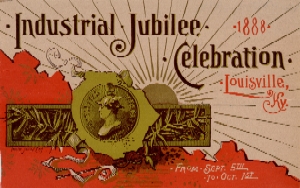 Shallcross bearing the King of the festival ‘Algol’
and his Dukes. “At four o’clock Thursday afternoon the dense
throng of people along the river sighted a gay craft bearing
down on the city from upstream. It was tricked out right royally
with bright ribbons and multi-colored flags.” The gorgeous
vessel steamed up and down the levee twice “as if in conscious
enjoyment of its own gaudy toggery.”
Shallcross bearing the King of the festival ‘Algol’
and his Dukes. “At four o’clock Thursday afternoon the dense
throng of people along the river sighted a gay craft bearing
down on the city from upstream. It was tricked out right royally
with bright ribbons and multi-colored flags.” The gorgeous
vessel steamed up and down the levee twice “as if in conscious
enjoyment of its own gaudy toggery.”
Ben Hur was the theme of the October 1890 Satellites of Mercury celebration. The parade was the “grandest of its kind,” and the Queen of the Ball was soon-to-be well-known artist Enid Yandell. Thousands of locals and out-of-state visitors spent thousands of dollars with hotels and local merchants. All of this was good news to a city that had been struck by a catastrophic tornado just six months earlier.
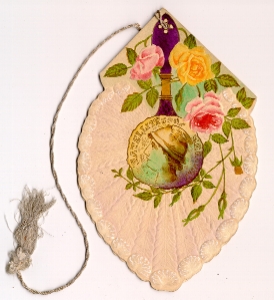 Mercury’s reign came to an end in 1892 when
the Satellites failed to gain enough subscriptions to produce
the parade. Businesses were being more conservative with their
advertising dollars, and without the revenue those funds
provided, the parade could not go on. In spite of the
difficulties, the Satellites decided to go ahead with the ball
on Nov. 18. According to The Critic, “it was very sad.”
The stage settings were disappointing, and the seats were hard.
The Satellites took possession of the ballroom floor until 1
a.m. It is not known whether this was selfishness on their part,
or just a lack of interest of the general public. Some of the
problems could have been caused by the absence of Peyton Clarke
who had resigned as Chief Satellite in 1890. Perhaps without his
artistic vision the magic was gone.
Mercury’s reign came to an end in 1892 when
the Satellites failed to gain enough subscriptions to produce
the parade. Businesses were being more conservative with their
advertising dollars, and without the revenue those funds
provided, the parade could not go on. In spite of the
difficulties, the Satellites decided to go ahead with the ball
on Nov. 18. According to The Critic, “it was very sad.”
The stage settings were disappointing, and the seats were hard.
The Satellites took possession of the ballroom floor until 1
a.m. It is not known whether this was selfishness on their part,
or just a lack of interest of the general public. Some of the
problems could have been caused by the absence of Peyton Clarke
who had resigned as Chief Satellite in 1890. Perhaps without his
artistic vision the magic was gone.
Although the Satellites are gone, their ideas live on. Louisville’s Derby Festival has many of the same elements the Satellites used over 100 years ago: a steamboat excursion, fireworks, gala receptions, and a parade.
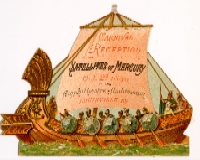 Sources researched for this article include
Louisville newspaper The Critic, Madison Dugan’s River
News, an article titled “Hang On! Here comes the Derby
Festival the 20th time around” by George Yater published in Louisville
Magazine, and other items from the library and special
collections of The Filson.
Sources researched for this article include
Louisville newspaper The Critic, Madison Dugan’s River
News, an article titled “Hang On! Here comes the Derby
Festival the 20th time around” by George Yater published in Louisville
Magazine, and other items from the library and special
collections of The Filson.
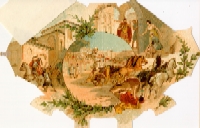
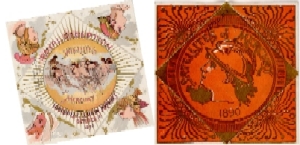
The Filson Historical Society
1310 South Third Street - Louisville, KY
40208
Phone: (502) 635-5083 Fax: (502) 635-5086
Hours
The Ferguson Mansion and Office
Monday - Friday: 9 am. - 5 pm.
Saturday and Sunday closed
Library
Monday - Friday: 9 am. - 5 pm.
Saturday: 9 am. - 12 noon
